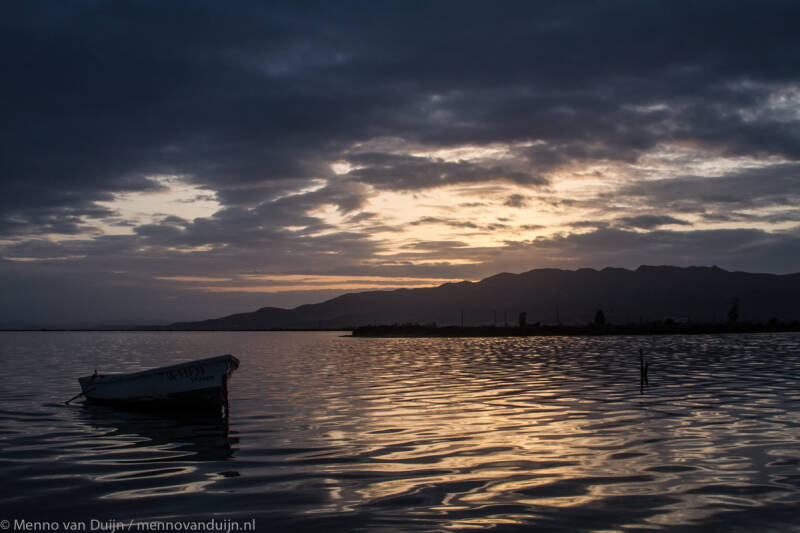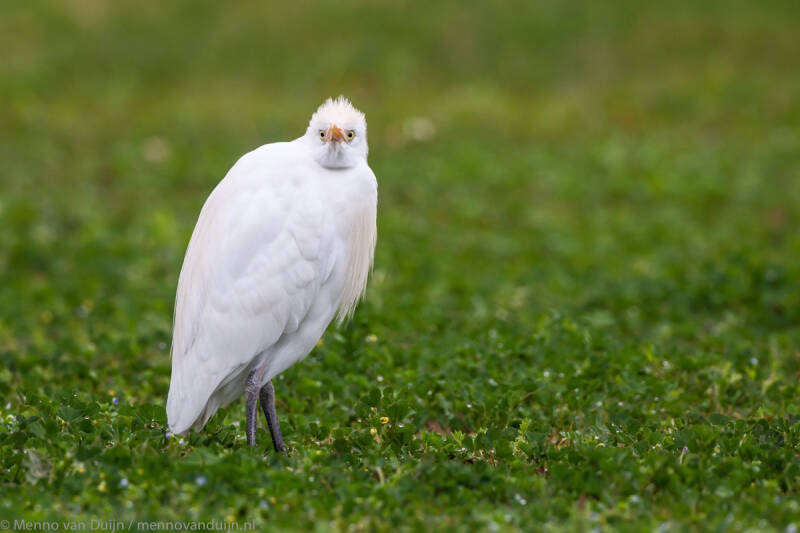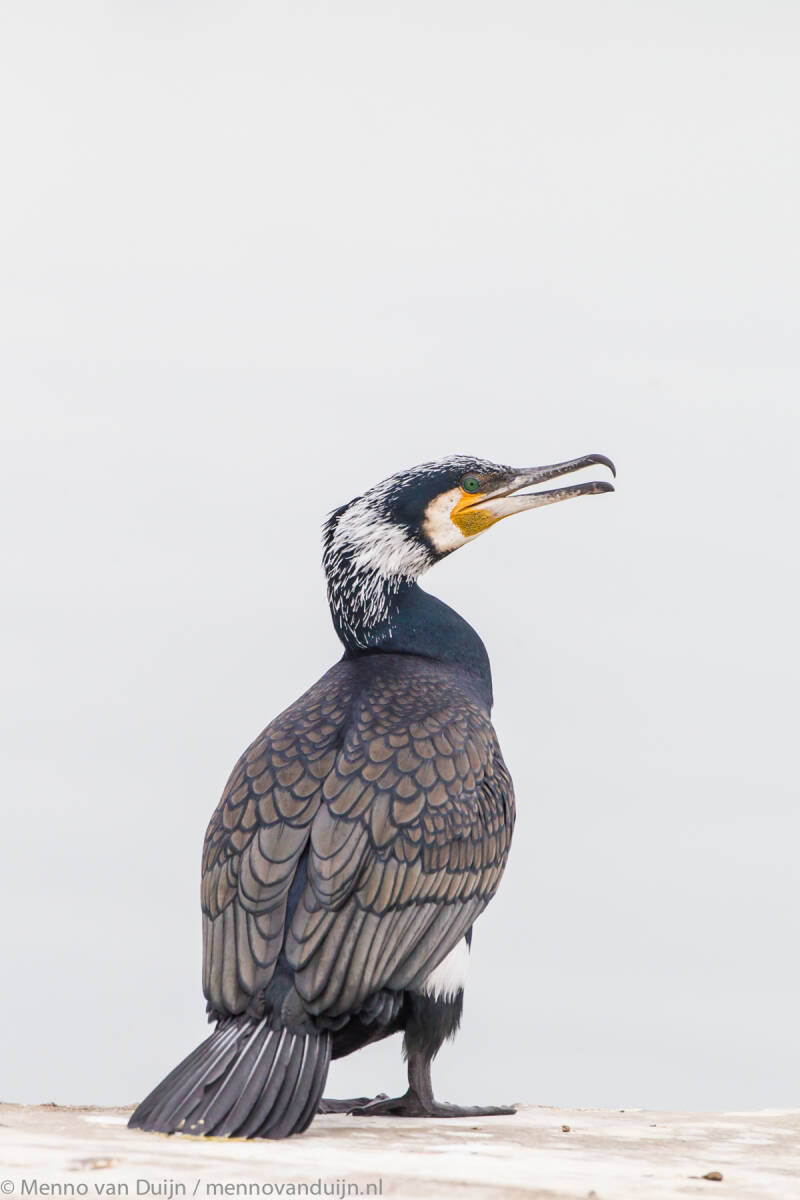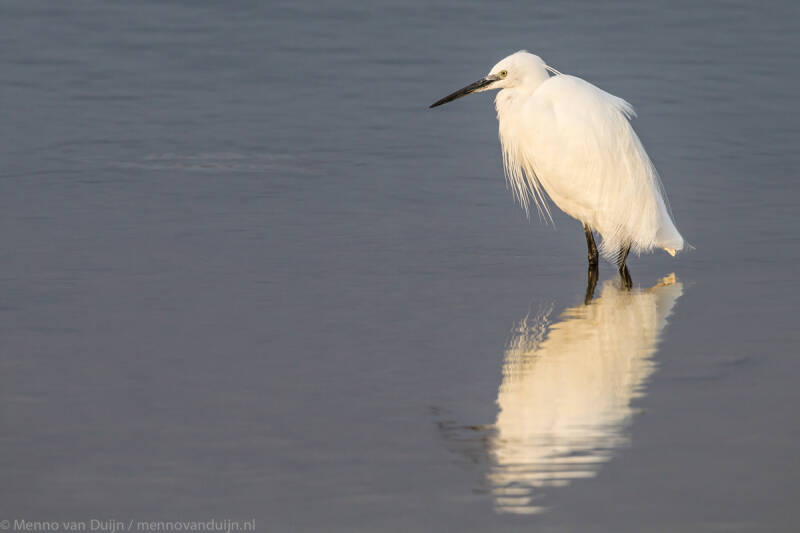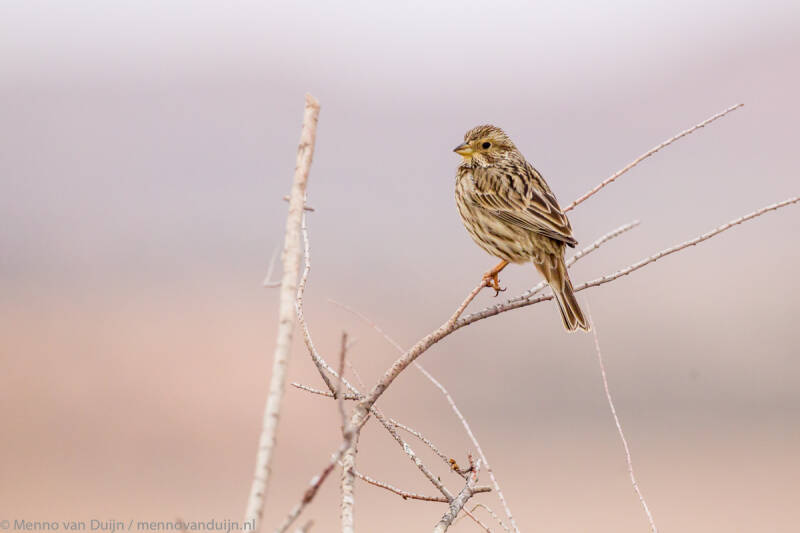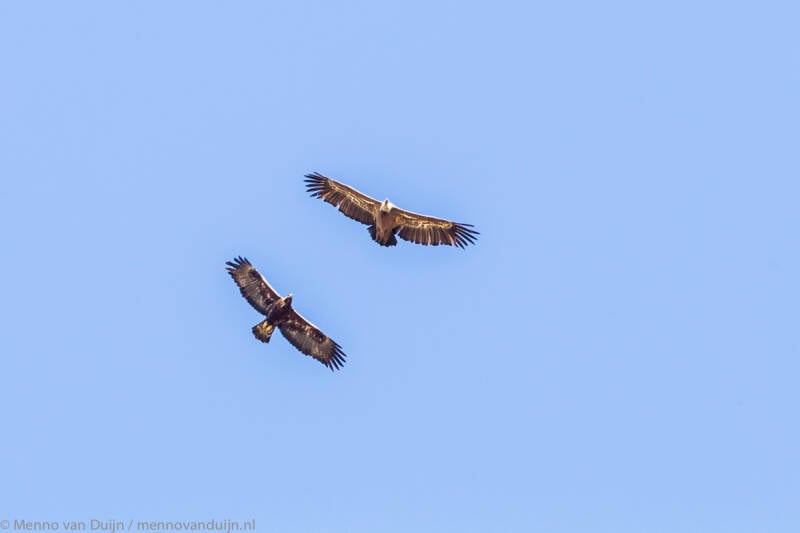
One of the most threatened birds in Europe is the Dupont’s Lark. The population is in a steep decline due to habitat loss and use of pesticides. It might be that the species goes extinct in Spain within a couple of decades. Therefore a reason to see it whilst still possible.
26 Februari 2022 Llobregat
We arrive at midnight at the airport and after picking up the rental car we head to our hotel at Castelldefels, just south of the Llobregat. While Saskia has a sleep in I head out to be at Llobregat with the first light.
It’s dark and it’s raining a bit so I drive around hoping to see some nocturnal birds or animals but only some Mallard fly out of the ditches. When it gets light I park on the north side of the airport and walk along the small canal. A Kingfisher flies by and it’s hard to miss the explosive song of the Cetti’s Warblers.
The reeds along the canal were loaded with Chiffchaffs and in the tamarisks the Sardinian Warblers were skulking. An unfamiliar call came from a flock of Red-billed Queleas that held up in the blackberry bushes.
The park would only open up later in the morning so I walked to the other observation points. From here I could find some Little Ringed Plovers and Lapwings on a mudflat and in the distant Red-crested Pochards, Northern Shovelers and Teals were on the open water.
On the agricultural fields I hope to find some Stone Curlews but could only see Crested Larks and some Spotless Starlings among the Common Starlings. Back at the car park a pair of Black Redstarts were foraging in the playground as were half a dozen Serins.
Back at the hotel I scanned the sea while having breakfast and at the horizon a feeding frenzy was going on with about 100 Scopoli’s Shearwaters. A stroll on the beach delivered a pair of Cirl Bunting in the vegetation while a handful of Audouin's Gulls were on the lookout for something to eat.
Barcelona, Parc Guell
Beside birds some cultural must sees were also on the list including Segrada de Familia, Parc Guell and the Ramblas. I had visited Parc Guell as a child with my family and remembered the Alpine Swifts flying by with the city in the background, but that was mid-summer.
No swifts now but plenty of other nice birds to be seen in this park. Many tits hang around this park, especially at the higher levels where it’s less busy with tourists, like Coal-, Blue, Long-tailed and Crested Tit. Other notable species are the Firecrest, Jay and you can’t miss the Monk Parakeets that breed in the palm trees.
After we visited the Ramblas and the harbour, where a Yellow-legged Gull was devouring a Collared Dove, we drove to our next stay, the Ebro Delta. We arrived at our stay in El Poble Nou del Delta (south delta) at night and when we got out of the car were welcomed by a Scops Owl calling.
27 February 2022 Delta del Ebre
In the morning I got out early to drive around the area. Most of the rice fields are dried out but in some there was some water left and that attracted many birds. White Wagtails chased the insects on the mud and in the deeper parts where the fish concentrated Great and Little Egrets just sat and waited for the Great Cormorant to chase the fish to the surface. Glossy Ibises found their food in the muddy ditches.
At mirador L’Embut I scanned the reedbeds where many Moorhens, Coots and Purple Gallinules were present. Some Snipes found cover but one of the many Marsh Harriers scared them out of their hiding.
When I return to El Poble Nou about 100 Crag Martins swirl around the buildings. After breakfast we take the car and drive around the gravel roads. In the canals some Common Sandpipers and Greenshanks are present. While we scan the sea suddenly a Caspian Tern with a fish flies overhead.
Near the visitors centre two Slender-billed Gulls are present among many Mediterranean and Audouin's Gulls.
It’s getting busier with tourists so we head north to go to mirador Migjorn. A light morph Booted Eagle flies by and we find a Hoopoe calling from one of the masts near a desolated farmhouse.
On our way back to the accommodation we come across a Water Rail and a couple of Grey Wagtails in one of the streams. In the last light of the day we find 17 Golden Plovers and some Northern Lapwings are present on a field near El Poble Nou.
28 February 2022 Delta del Ebre
We start with the same routine and this time Saskia joinse me. We start in the area of the visitor centre to be the first before all birds are pushed further into the reserve by the tourists.
We scan the flocks of Greater Flamingo’s if we might find the Lesser Flamingo but it’s in vain. A couple of Little Stints and a Bluethroat are a nice addition to the list. Before we head back to check out at the appointment and head to Belchite.
Belchite
The more we drive on into the hills the more Griffon Vultures we see along the N-232. We then take the A-1307 through the impressive steppe landscape. On a look-out half way to Belchite we see two Golden Eagles in an aerial display.
We arrive at Belchite in the afternoon and walk around the impressive ruins. Two Ravens fly overhead and we see three Blue Rock Thrushes on the ruins. Many thrush are present in the olive trees including Mistle, Song, Blackbirds and Redwings.
We are based near Zaragoza for the next two nights and stop at the car park along the A-222, one of the famous places for Dupont’s Lark, to check the site for the next morning. We already see the Calandra -, Lesser Short-toed, Thekla- and a single Greater Short-toed Lark.
West from here lies La Salada, a small salt lake. The dirt road is quite a challenge, even for our SUV. Iberian Grey Shrike observes us but clearly had more interest in the insects. We park the car and a flock of Corn Buntings fly into a tree. An odd call get’s my attention and in the distance I see the silhouettes of some sandgrouses. We head into the direction and find a group of at least 100 Pin-tailed Sandgrouse in the evening light.
1st of March 2022 Belchite.
Tensions are high when we park the car at the A-222 with the first light at the horizon. It’s cold while we carefully walk on the sand path away from the traffic noise. It’s getting lighter and lighter and then we hear the melodious song of Dupont's Lark. The Calandra and Lesser Short-toed Larks are doing their part from a singing post or air but even though we count about 7 singing Dupont’s we can’t see one.
The sun is rising and the bird activity is getting less. We head to Belchite for breakfast and coffee in the sun. We went shopping to have a picnic at El Planeron. At an old farm just before the junction to El Planeron two pairs of Lesser Kestrel are flying around to check out the nesting site. A fantastic adult male Hen Harrier patrolls the fields.
We parked the car to have a picnic while looking over Balsa del Planeron. A handful of White Stark are wading while looking out for something edible. A Shoveler and three Teal were resting in the half submerged trees. Two Black-bellied Sandgrouse landed on the other side to have a drink and quickly took off. While enjoying lunch and the scenery suddenly a Dupont’s Lark started singing…. Sunrise myth busted!
The afternoon was spent sight-seeing in the centre of Zaragoza where two Carrion Crows were an addition to the list.
2nd of March El Planeron, Belchite.
In the early morning I drove back to El Planeron and when I lowered the window I could already hear Dupont's Lark singing. Two other birders were there too so I took one of the (dead end) side roads. When I turned the car around a lark ran over to the other side…
My heart started pounding and slowly drove to the spot with my camera ready. Due to the overcast sky there wasn’t much light. My eye caught a preening bird in the vegetation. I got it in the frame and the dark back, long narrow bill and flat crown could only mean one thing. A Dupont’s Lark was sitting next to me, I tried to keep the camera and lens as steady as possible and managed to get some decent shots despite the low shutter speed. Then the bird ran off into the vegetation. Wow….. I didn’t expect to have such an encounter with this elusive bird.
I tried some more roads, and briefly saw another bird flying a couple of metres before vanishing in the shrubs. Some Red Partridges and Red-billed Gouch sat on a rock formation but were too shy for any good photos. I had another look at the Lesser Kestrels where also the male Hen Harrier flew by again to end the morning with.
Riglos
We got a message from our hotel that they couldn’t receive us as there was no electricity. We decided to see by the end of the day where we ended and then look for another accommodation in the area.
Riglos was next on our planning. The clouds were getting greyer and it started to rain till we got close to Riglos. At Ayerbe we stopped for a coffee and to do some shopping. We just walked 100 metres when suddenly about 1000 Cranes came over the ridge and used the thermal of the village to gain height. A fantastic sight with their calls echoing, you couldn’t hear the passing cars anymore.
Just before we arrived at Riglos the sun came out. The sun lights the famous rock formations with the dark clouds as a dramatic background. Now the thermal started to build and hundreds of Griffon Vultures took off from the rocks.
We decided to do the 5k walk around the rocks, but had to stop every hundred metres because of the fantastic sight. There were many Hawfinches around and a flock of Long-tailed Tits came by. The berries of the ivies in the villages attracted tens of Blackcaps and two Citril Finches flew by when we were near the top.
By the time we came back to the car it was getting late and about 60 Red-billed Cough gathered on the rock for their roost. We looked online and found a nice hotel at Bierge.
3rd of March Bierge and Casbas de Huesca
When we opened the curtains we saw Griffon Vultures passing by at almost eye-level, flying down from the mountains into the valley. In the blossoming cherries more than a dozen Hawfinches were present.
After our breakfast we checked out and first stopped at Salto de Bierge. I hoped for a Dipper near the waterfall but only a Grey Wagtail showed itself and I was treated with even better sighting, a beautiful Wallcreeper crawled over the rocks, flickering his red wings.
Every Saturday volunteers feed the vultures at Casbas de Huesca, only today it was Thursday. Still many Griffon Vultures were present soaring over the place. We hiked up the hill. An immature Bearded Vulture was chased away by an adult which then picked up a bone and flew away out of sight.
A male Dartford Warbler was very showy but kept his distance to get a good shot. Meanwhile a Crossbill flew overhead and so did two Golden Eagles.
Montserrat
Our last stop on the way back to Barcelona was at Montserrat. Another place I had visited with my family as a child and I remembered the Rock Martins and Rock Sparrows. I didn’t see any recent sightings anymore but the place is worth a stop to add some culture to the trip.
Well, the place has undergone a huge facelift and I don’t think you want to be there during the tourist peak… Everything has been commercialised and only notable birds were a Peregrine and some Short-toed Treecreepers. Even though it’s lost the charm, it was nice to be at the place I was 25 years ago.
The trip resulted in 130 species. Lifers for me were Dupont’s Lark and Pin-tailed Grouse. Sadly missed Black Wheatear beside several attempts and we just missed the White-tailed Lapwing and Lesser Flamingo at the Ebro Delta.
All sightings can be found at spain.observation.org
